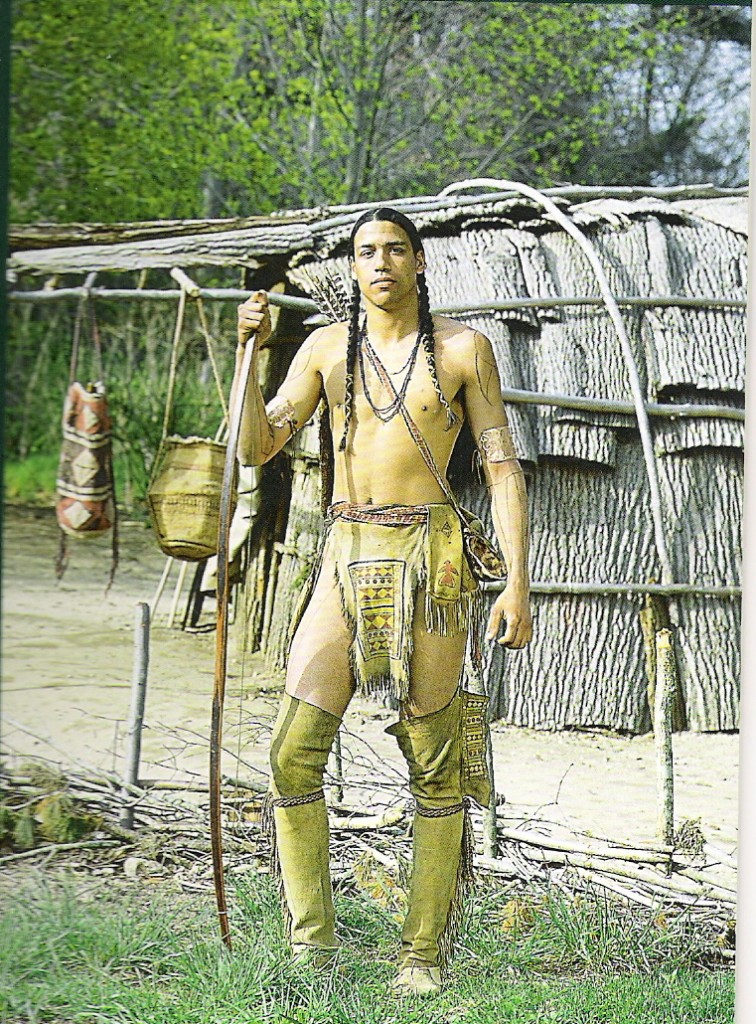
Wampanoag Man
Every year we talk about the pilgrims and have Thanksgiving dinner. We love the family traditions that we have that surround this holiday.
In honor of the holiday, I want to give you some new ideas and fun ways to celebrate and learn about this American holiday.
After doing a quick search, less than 15 minutes, I decided on three topics that I will cover in the two, remaining weeks until Thanksgiving and the week following. You can use these ideas to teach your children some new and interesting things about this American holiday. Here are the topics and when they will be published on this blog.
1. The Wampanoag Indians – November 9 for November 14-18
2. Learn about Ships and Sailing on the Mayflower – November 16 for November 21-25
3. Life of the Pilgrim Children in Plymouth – November 23 for November 28-December 2
Enjoy your Thanksgiving holiday!
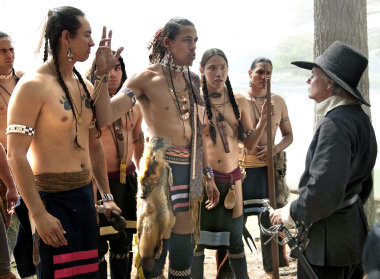
Who were the Wampanoag Indians?
The Wampanoag Indians were the tribe that met and befriended the Pilgrims who landed at Plymouth. Their chief at that time was a man named Massasoit. He was a peaceful man but his sons had many wars with the Pilgrims. In this article, I am going to give you some information and activities that will help you learn more about this man and his people.
Wampanoag Activities for children:
1. Wampanoag facts game. Have an older child create cards with one fact on each card. You could cut and paste the facts from this article and print them off or handwrite them. Talk about the cards and the information that they have on them. At dinner have dad ask a question about the information on the card and see how well the family remembers. Play this game a number of times at a number of meals.
Interesting facts about Wampanoag Indians:
• Wampanoag means “easterners.” Originally it was pronounced similar to WAWM-pah-NAW-ahg. But today, most Wampanoag people pronounce the name either wamp-a-NO-ag or WAMP-ah-nog (“wamp” rhymes with “stomp.”)
• The Wampanoag Indians were original natives of Massachusetts and Rhode Island.
• The Wampanoag tribe has its own reservation on Martha’s Vineyard today. Reservations are lands that belong to Indian tribes and are under their control. The Wampanoag tribe has its own government, laws, police, and other services, just like a small country. But the Wampanoag are also US citizens and must obey American law.
• There are about 300 members of the Wampanoag tribe today on the reservation, but many other people of Wampanoag descent live elsewhere in Massachusetts and Rhode Island.
• The Wampanoag didn’t belong to a larger Wampanoag government like the Iroquois and other native confederacies. Their villages were autonomous. That means each band made its own political decisions.
• Wampanoag children had cornhusk dolls and toys such as miniature bows and arrows and hand-held ball games.
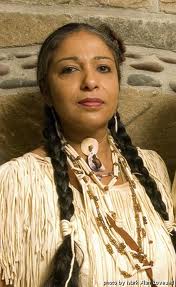 • Wampanoag mothers traditionally carried their babies in cradleboards.
• Wampanoag mothers traditionally carried their babies in cradleboards.
• Wampanoag men were hunters and sometimes went to war to protect their families. Wampanoag women were farmers and also did most of the child care and cooking. Both genders took part in storytelling, artwork and music, and traditional medicine.
• They lived in villages of small round houses. The Wampanoag houses were called wetus, or wigwams. Wigwams are small houses, usually 8-10 feet tall. Wigwams are made of wooden frames which are covered with woven mats and sheets of birch bark. The frame can be shaped like a dome, like a cone, or like a rectangle with an arched roof. Once the birch bark is in place, ropes or strips of wood are wrapped around the wigwam to hold the bark in place. See pictures of a woman building a wigwam .
• Wampanoag clothing: Women wore knee-length skirts. Wampanoag men wore breechcloths with leggings. Neither
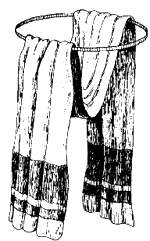
breechcloth
women nor men had to wear shirts in the Wampanoag culture, but they would dress in deerskin mantles during cool weather. They wore moccasins on their feet. See the clothing.
• The Wampanoag didn’t wear long headdresses like the Sioux. Usually, they wore a beaded headband with a feather or two in it.
• Wampanoag women had long hair, but a man would often wore his hair in the Mohawk style or shave his head completely except for a scalp lock (one long lock of hair on top of his head.) Wampanoag warriors also painted their faces and sometimes decorated their bodies with tribal tattoos.
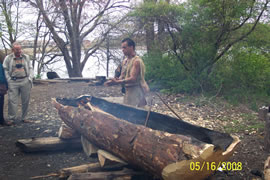
• The Wampanoag made dugout canoes by hollowing out huge trees. They used them for transportation and ocean fishing trips. Overland, the Wampanoag tribe used dogs as pack animals.
• Everyone in a Wampanoag family cooperated to gather food for the tribe. Women harvested corn, squash, and beans. Men hunted for deer, turkeys, and small game and went fishing in their canoes. Wampanoag children collected other food like berries, nuts, and herbs. Some traditional Wampanoag recipes included soup, cornbread, and stews.
• Wampanoag hunters and warriors used bows and arrows and heavy wooden clubs. Fishermen used nets and bone hooks.
2. Find Massachusetts and Rhode Island on a map. Why not make and color your own map showing where the Wampanoag people lived.
3. The Wampanoag language Memory game. The Wampanoag language has no native speakers today, so these vocabulary words come from 18th- and 19th-century sources, and their pronunciation is uncertain.
Have an older child create a “Memory” game using pictures, English words, and Indian words. On index cards print the English word and a picture of the animal or item. On another index card print the Indian word with a picture of the animal or item. Place the cards face down and match the pictures as you take turns turning them over two at a time. It will be fun seeing the English word and the Indian word with the pictures to help make the match.
The Wampanoag language:
Wuneekeesuq (pronounced similar to wuh-nee-kee-suck) Good day
Wetuis house
One Aquit
Two Nees
Three Nis
Four Yoaw
Five Abbona
Dog Aunum
Sun Cone
Moon Appause
Water Nippe
White Wompey
Red Squi
Clam Suckis
Wolf Ontoquas
Bear Maske
Deer Ottucke
Fox Whauksis
Raccoon Ausupp
Rabbit Motuckquas
Squirrel Shannucke
Owl Wewes
Snake Askooke
Frog Tunockuquas
4. Have a seafood meal. Thanksgiving is a holiday that celebrates the bounty of the land. But natives that were already here got a good portion of their food from the sea. Have a meal and serve clam chowder, oyster stew, or any other fish meal.
Indian Salmon Cakes
1 lb. canned salmon, flaked (drained, but reserve liquid)
4 juniper berries, crushed
1/2 cup cornmeal
2 eggs, lightly beaten
1/3 cup milk (easy does it)
Mix salmon, juniper berries, cornmeal together. Add eggs.
Add milk very slowly only as needed to moisten OR use the salmon can liquid for added flavor but be very careful not to add too much liquid overall. Cakes should be just moist enough to spoon together or form into little cakes by hand (two inches across makes for a nice appetizer size).
Spoon onto a well-greased baking sheet. Bake in a moderate oven, 350 degrees F, for 30 minutes. You can also fry them with a little oil in a nonstick pan until golden brown. Serve hot or cold.
Top each cake with a dab of mayonnaise or tartar sauce if you like.
Special Note: You can use a combination of cornmeal and plain crumbs if you like, adding more dry ingredients as required to hold cakes together.
 5. Make a Ring and Pin game. The Wampanoag children played the Pin Game. A ring was attached to a stick and you had to flip the ring onto the stick.
5. Make a Ring and Pin game. The Wampanoag children played the Pin Game. A ring was attached to a stick and you had to flip the ring onto the stick.
7. Have an early Thanksgiving meal using traditional Wampanoag recipes.
Wampanoag Indian Food:
Nasaump is a traditional Wampanoag dish that is made from dried corn, local berries, and nuts. It is boiled in water until it thickens and is similar to porridge or oatmeal.
1 1/2 cups cornmeal
1 cup strawberries, raspberries, blueberries, or a combination of all three
1/2 crushed walnuts, hazelnuts, sunflower seeds, or a combination of all three
1-quart water
maple syrup or sugar to taste (optional)
Combine cornmeal, berries, crushed nuts, and the optional sweetener in a pot of water and bring to a boil. Turn down the heat to medium and cook, stirring frequently, for 15 minutes.
Turkey Sobaheg. Sobaheg is the Wampanoag word for stew. Like most stews, this dish is easily adapted to seasonal ingredients. The ground nuts help to thicken the sobaheg. Variations of this dish are still made in Wampanoag country today.
1/2 pound dry beans (white, red, brown, or spotted kidney-shaped beans)
1/2 pound white hominy corn or yellow samp or coarse grits
1 pound turkey meat (legs or breast, with bone and skin)
3 quarts cold water
1/4 pound green beans, trimmed and cut into 1 inch-lengths
1/2 pound winter squash, trimmed and cubed
1/2 cup raw sunflower seed meats, pounded to a course flour (or pounded walnuts)
dried onion and/or garlic to taste
clam juice or salt to taste (optional)
Combine dried beans, corn, turkey, seasonings, and water in a large pot. Bring to a simmer over medium heat, turn down to a very low simmer, and cook for about 2 1/2 hours. Stir occasionally to be certain the bottom is not sticking.
When dried beans are tender, but not mushy, break up turkey meat, removing skin and bones. Add green beans and squash, and simmer very gently until they are tender. Add sunflower or nut flour, stirring until thoroughly blended.
Boiled Bread is a small patty made mostly of cornmeal with crushed nuts and berries added in. It is dropped in a pot of boiling water and when done, rises to the top.
1 quart slightly boiled water
1/2 cup cornmeal
1/2 cup cornflour
1/2 cup dried cranberries, blueberries, and/or currants
1/2 cup crushed nuts or seeds (walnuts, hazelnuts or sunflower seeds)
Maple syrup or sugar to taste (optional)
Combine all ingredients in a large bowl and mix thoroughly. After mixing, slowly add a spoonful at a time of slightly boiled water. When the mix is thick enough to be sticky, shape round patties (about 3 inches in diameter and 1/2 inch thick). Return water to a slight rolling boil and drop in 1 or 2 patties, carefully making sure they do not stick to the bottom. Remove breads when they begin to float.
8. Build a miniature wigwam.

Books about the Wampanoag for children:
- Massasoit, Friend of the Pilgrims by Virginia Frances Voight
- Children of the Morning Light by Manitonquat. A wonderful collection of traditional legends retold by a Wampanoag elder.
- Clambake: A Wampanoag Tradition by Russell Peters
- Wampanoag (Native Americans by Barbara A. Gray-Kanatiiosh
- Tapenum’s Day by Kate Waters Life before 1620.
- Weetamoo: Heart of the Pocassets, Massachusets – Rhode Island, 1653 by Patricia Clark Smith
Much of the above information came from articles written by Laura Redish and Orrin Lewis and the title of their site is Native Languages of the Americas.
Possibly Related Posts:
- My Christmas Gift to You
- Why take Your Kids Camping?
- Make it Special – Chores and Family Work
- Martin Luther King Day and Black History Month
- Tools to Make 2013 Better – Say NO to New Years Resolutions!!


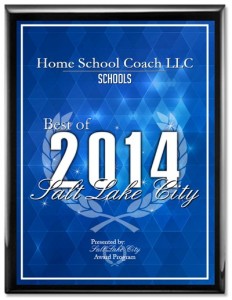
{ 2 comments… read them below or add one }
Just finished reading the book “Caleb’s Crossing” which inspired me to search for the Wampanoag Indian tribe. Greatly appreciate the oppotunity to read and learn more about this culture. Thank you.
You are so welcome. I found them fascinating too.